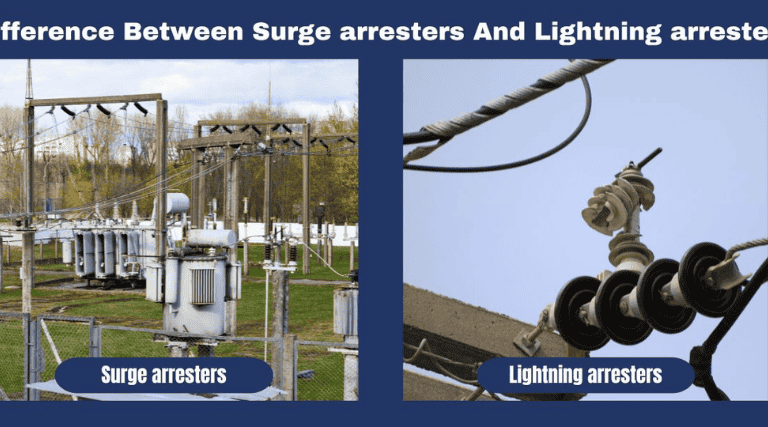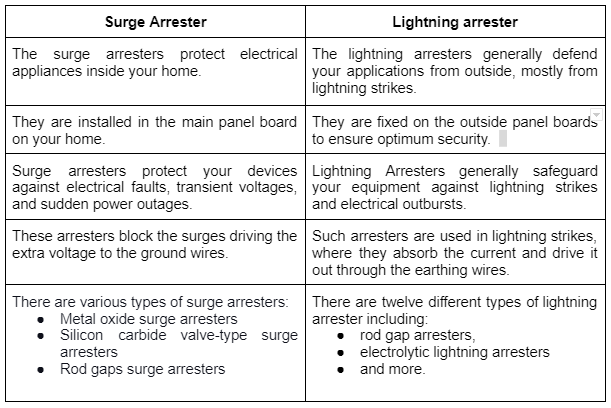- Home
- About Us
- Blog
- Services
- Equipment
- Online Testing
- Offline Testing
- Partial-Discharge
- CPC 100 Multifuncational Switchyard
- Vlf Tan Delta Measurement
- Current Signature Analysis
- Relay Measurement
- CT Measurement
- SFRA Measurement
- Moisture Analysis by PDS & PDC
- Turns-Ratio-Measurement
- Winding Resistance Measurement
- OLTC-DCRM-Measurements
- Frequency Response stray Losses
- Circuit Breaker Analyzer & DCRM Test
- Circuit Breaker Timer
- Contact Resistance Meters
- Particle Count Tester-Pamas
- TRAX Multifunctional switchyard Diagnostic Test
- TESTRANO-600
- Surge Tester-jabbals
- Circuit Breaker Analyzer
- Gallery
- Careers
- Contact Us
Difference Between Surge arresters And Lightning arresters

Surge arresters and lightning arresters are often confused interchangeably. This is mostly because both of them are used to keep your electrical applications safe and secure. With the advancement and adoption of new technologies, and mostly electrical systems, it’s important to understand what is a surge arrester and what is a lightning arrester in detail. In this article, we will go deeper and understand the surge arresters and lightning arresters in detail and highlight the key differences that make them unique to their name.
In this article, we will explore the difference between a lightning arrester and a surge arrester, explaining what each one is and how they function and answering the frequently asked question about what is a surge arrester and what is a lightning arrester.
What Is A Surge Arrester?
These electrical devices help protect your electrical equipment by limiting the voltage surges and the current flow. In the main current line, voltage surges often occur due to various factors like lightning, power outages, temporary overvoltage, etc. This fluctuating voltage can be harmful to your appliance. That’s where surge arresters come into place.
Surge arresters help deviate the excess current and limit the voltage to prevent overpressuring your electrical appliances, protecting them from electrical outbursts or short circuits. Surge arresters can be used for various appliances, homeware, or utility substation equipment.
What Is A Lightning Arrester?
The most common and destructive voltage surges occur during lightning. Lightning can lead to high transient voltage, sparks, surge currents, etc. Thus, a lightning arrester is used to protect electrical equipment against lightning.
A lightning arrester is generally placed higher, like on top of transmission poles, buildings, or towers. The system is well connected through ground wires and securely discharges the current using earthing. When the lightning surges, the lightning arrester absorbs the high voltage current and slowly discharges it through the ground wires, reverting back to normal.
Lightning Arresters are generally used for heavy appliances that need protection, while surge arresters are installed to handle common voltage fluctuations.
A Few Other Related Terms To Know
There are a few other terms you must be aware of when learning about surge and lightning arresters. Some of the major ones are:
- Surge suppressor: It is a device installed to protect your home wiring from voltage fluctuations. A surge protector, or suppressor, is installed on the home distribution board to protect the electrical system from internal fluctuations of the contractor switch itself while also protecting it from main current fluctuations.
- Lightning rod: It is a metal rod installed on top of buildings, towers, and poles to protect them from lightning. If a lightning strike directly hits the current lines, it may lead to a dangerous situation involving voltage crashes, power outages, and sometimes even electrical blasts. Hence, a lightning rod, also called a lightning conductor, is installed to prevent these dangers.
Key Differences Between Surge Arrester And Lightning Arrester

Types of Lightning Arresters
There are various varieties of arresters when we talk about lightning arresters. Some of them are:
- Electrolytic lightning arresters
- Rod gap lightning arresters
- Expulsion-type lightning arresters
- Valve-type lightning arresters
- Metal oxide lightning arresters
- Oxide film lightning arresters
- Sphere gap lightning arresters
- Horn gap lightning arresters
- Multiple gap lightning arresters
- Impulsive protective gap lightning arresters
- Thyrite lightning arresters
- Auto valve lightning arresters
Surge Arresters Or Lightning Arresters: Which One Do You Need?
This is a contradicting question. Surge arresters or lightning arresters? After you’ve learned what is a surge arrester and what is a lightning arrester and analyzed their key differences, you pose the most important question- which one of them do you need?
To answer this, it depends on your needs and reasons. Both of the arresters are well-suited and perfect devices to protect your homes, eliminating your electrical risks. And if you’re looking around for arresters for your home security, you can get either of them installed.
Maintenance Of arresters
Proper and dedicated maintenance of arresters is required to ensure complete security and safety. Be it a surge arrester or a lightning arrester, both require timely care to lead to proper functioning. Some of the general tips you can follow are:- Inspect them at least once per year or half-yearly in case of severe climatic areas or conditions.
- Check for loose connections, as they might lead to high-resistance joints
- Make sure all system components are secured on their mounting surfaces
- Keep a check record for corrosion of internal components of the arrester
- Ensure a clean space around the arrester to avoid contamination and corrosion in the future.
- Evaluate performance tests to check the functioning of the arresters
- Keep a record of ground wire connections and their functioning
Can A Surge Arrester Be Used As A Lighting Arrester?
Did you know that surge arresters can replace a lightning arrester, but you cannot use a lightning arrester as a surge arrester? As both surge arresters and lightning arresters are designed to provide security against voltage surges and transient voltages, a surge arrester can be used as a lightning arrester in general cases.
While surge arresters are more flexible and can handle broader outages, lightning arresters are structured to handle massive surge currents through lightning strikes. Hence, surge arresters can be used in place of lightning arresters as a temporary security measure. However, lightning arresters are more suitable to be installed in the long run to ensure the effective protection and functioning of your applications.
Conclusion
Both lightning arresters and surge arresters are important electrical systems designed to protect our electrical appliances from potential electrical surges and lightning damage. You can get any of them installed, as they are almost identical except for some of the key differences we identified. However, after understanding what a surge arrester and a lightning arrester are, you must have understood how different their purpose and performance are. While you may select anyone, you must consider your needs and preferences in the first place to ensure a safe and secure environment.FAQs:
- What Is The Difference Between Surge Arresters And Surge Suppressors? Surge arresters can deal with high-voltage surges without affecting the insulation, while surge suppressors have a low voltage capacity and cannot withstand harsh voltage surges.
- Do Lightning Rods Attract Lightning? Yes, a lightning rod is designed to attract and absorb lightning, leading it to the ground through an electrical pathway. It helps to prevent any potential damages to buildings and structures.
- Where are surge arresters located? A surge arrester is generally found inside the main panel board of your home electrical system.
